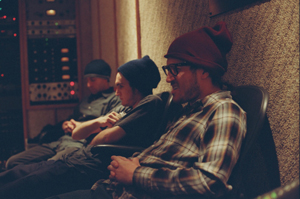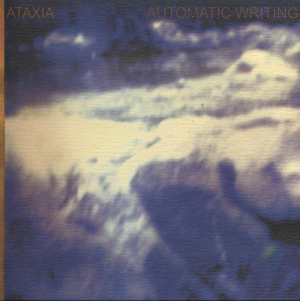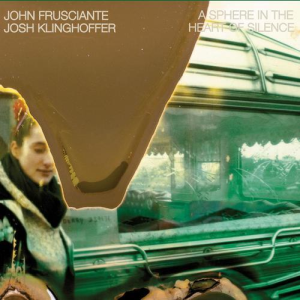JOHN FRUSCIANTE - SIDE PROJECTS
ATAXIA

| Years active: | Genres: |
| 2004 | Progressive Rock |
Part of Frusciante's 2004 release strategy, Ataxia was a short-lived collaboration project between Frusciante, Joe Lally of Fugazi and Josh Klinghoffer.

AUTOMATIC WRITING
| Release year: | Rating: | Key tracks: |
| 2004 | 5 | "The Sides" |
1) Dust; 2) Another; 3) The Sides; 4) Addition; 5) Montreal
Supergroup jamming. Whatever guttural feeling that latter word just gave you, that's going to be your take on this.
Chronologically the second of Frusciante's release flurry during the latter half of 2004, the Ataxia album was to show that the scope of the project (if you want to call it that) was beyond just him releasing new records solely under his own name. were a short-lived band between Frusciante, frequent brother-in-arms Josh Klinghoffer and Fugazi's Joe Lally who had a few jam sessions, recorded some of them, played a single gig and then "disbanded" when when everyone's collective attention span moved onto something else. It was never meant to be anything more than friends playing some music together for a little bit, and the fact that we have a couple albums of material released under their name (both recorded during the exact same session but released years apart) is largely because at this point Frusciante recorded absolutely everything he took part in. Automatic Writing can't really be called a debut album or even a supergroup passion project: it's a musical snapshot captured by happenstance.
The five songs on Automatic Writing are all essentially lengthy jam moments. The rhythm section builds up a steady backbone for the songs while Frusciante fills the spaces in sound with his guitar, opting for more abstract, atmospheric tones with it. The whole thing has a bit of a hazy atmosphere to it, something where the mood and sound is meant to be stronger than structure. And they're long jams - the shortest song clocks at six and a half minutes while the average length runs comfortably around nine minutes or so. Most of those minutes are spent repeating the same passages over and over again, building up the mood and the tension while gradually introducing the occasional new variation. Each song features vocals (with all three members getting their turn) but it's perfunctory: you could turn each song into an instrumental without losing anything, with the singing just acting as a formless additional element more there for the melody than for the lyrics. Frusciante's also the only one with enough gusto to be a lead singer, while the other two fade into the background texturally.
Jam bands admittedly never did much for me, and while purely in terms of performance Ataxia is more than adequate, there's a point where atmospheric wallowing turns into meandering and Automatic Writing frequently crosses that line. Much of the music on it is interchangable with one another, to a point that no impression is left behind beyond the vague overall feeling of the entire record. There's of course obvious differences between, for example, "Dust" and "Montreal" (one's a build-up, the other one's a come-down), but they're only apparent while listening to the record and if you're paying attention: after the album's over, it's all merged into one big murky sameness and whatever high and low spots have faded within the general sea of mediocrity. The sole exception is "The Sides", which sounds like a Frusciante solo song: it's tonally different from the rest by being instantly more driven and dynamic, it has some progression, evolution and change, Frusciante's voice is dead center and invested, and it sounds like it actually has a goal and a purpose. It's close to great and its explosiveness is a far cry from the rest of the album - if there's one thing to take away from Automatic Writing, this is it.
The whole point of Ataxia was for three friends to lose themselves in music for a while and the recordings were never a priority, and much like with most jam sessions the main resonance the music carries is the harmony between its players and the feeling of everything syncing together between the three individuals. For me listening to jam sessions inevitably makes you feel like an outsider sitting by the side and not invited in. What's being observed may be impressive in one level or another, but the magic that happens doesn't come across if you're not actually one of the people playing. Automatic Writing is that to a tee. If you're coming across this because you're binging through Frusciante's 2004 project, this is the dud of the lot. If you're listening to this beyond that context, I'm mainly just wondering why.
Physically: Same as all the other 2004 Frusciante releases: simple digipak with a barebones booklet.
JOHN FRUSCIANTE & JOSH KLINGHOFFER

| Years active: | Genres: |
| 2004 | Electronic, Art Rock |
While Frusciante and Klinghoffer were best buddies throughout 2004, they only released one album fully credited to both.

A SPHERE IN THE HEART OF SILENCE
| Release year: | Rating: | Key tracks: |
| 2004 | 8 | "Sphere", "The Afterglow", "Communique" |
1) Sphere; 2) The Afterglow; 3) Walls; 4) Communique; 5) At Your Enemies; 6) Surrogate People; 7) My Life
Frusciante and Klinghoffer dedicate an entire album to their chemistry, arm themselves with synths and loops and and forge something brand new to both, to rewarding results.
When reviewing Frusciante's 2004 albums, I've frequently called Josh Klinghoffer his brother-in-arms, co-conspirator, et cetera. The rush of releases Frusciante put out during the year was probably half thanks to Klinghoffer: not just with the obvious collaborative projects like this and Ataxia, but Klinghoffer was also a frequent backing musician for Frusciante on the albums credited solely to his name, even extending as back as before the official start of the project, on Shadows Collide with People - where Klinghoffer even got a co-lead vocal on one song and was immortalised in the promo photo in the liner notes. Klinghoffer's constant support is probably just as integral to the success of the project as Frusciante's seemingly endless creativity. A true collaborative project was inevitable and A Sphere in the Heart of Silence is a fitting culmination of the two men's shared work ethics, with both J's sharing equal amounts of airtime and space.
A Sphere in the Heart of Silencebreaks away from the general genre umbrella of the release chain by going towards a more electronic route, but the relatively stripped down and raw aesthetics the releases share remain in place. The album is full of synths, programmed elements and drum machines, but it still sounds like two guys in the same room playing everything live - which is likely how it was as well - with little imperfections left in to retain the authenticity. The opening instrumental "Sphere" and its bubbling, eight-and-half minute analog synth jam is an appropriate demonstration. It's a steadily chugging soundscape where the two artists layer one element - from new synth riffs to a guitar solo - on top of another, transforming the piece from a brief intro sequence into a quietly colossal wave of gorgeous retro synth sounds that envelops the room within itself. You could have had an entire album full of free-form soundscapes like this and I could have been sold, but while it's the kick that starts the whole thing going and signals the drastic difference from the prior Frusciante albums, it's hardly the only trick it's got.
Where the rest of the 2004 set of Frusciante-lead albums each took a particular idea and ran an album with it, Sphere's only combining factor between its seven tracks is that they're all heavily based on those synthetic elements - after that starting point, they are free to go anywhere. The same variety goes for the vocals as well, where both of the dynamic duo get two songs each to lead as well as two further songs where they share the microphone. They all have emphasise certain elements of the overall concept and Frusciante's songs in particular go for the extremes. "My Life" is the complete antithesis of "Sphere" and fittingly served as the other bookend, closing the album with a naked piano ballad barely over a minute long, but giving it a particularly striking finality. "The Afterglow" meanwhile is the fury and heat of the album, built on top of a propulsive drum loop, smoothly flowing bass part and a hectically riffing guitar: it's a manic pseudo-dance track where Frusciante goes through the full range of his vocals, flicking between neurotic shouting and ethereal falsettos. The former is a surprisingly memorable finale for the album, while the latter is one of its key standouts.
Meanwhile Klinghoffer's leads take a calmer route: "Communique" is a particularly haunting piano piece that utilises the space in the production to a great degree, making it into particularly effective headphone listening, and "At Your Enemies" takes that atmospheric angle and adds a backbone to it: they're respectively one of the album's most arresting cuts, and the one clear sort-of-filler it has to offer. The two duets on the other hand slot somewhere in the middle. "Walls" is a post-apocalyptic synth pop jam, starring a flurry of discordant vocal trade-offs between Klinghoffer's whispers and Frusciante's guttural screams over a stuttering mechanical rhythm and buzzsaw synths; it's the most electronica-heavy song of the lot. Meanwhile "Surrogate People" is downright conventional in comparison, boasting a traditionally straightforward rock arrangement underneath it that could have probably worked on any of the other Frusciante albums; here though, the striking synths take it over and seize control, turning it into a gothic slow-burner anthem dripping in moodiness.
>At seven songs A Sphere in the Heart of Silence feels criminally, or teasingly, short (even if due to song lengths it reaches nearly 40 minutes) because this is one of the most rewarding of the '04 album series. The whole album series has been a tribute to creativity but it's largely been restricted to highlighting already established facets of Frusciante's talents: out of the lot, this is the only one that represents setting sail towards uncharted waters and actually brings in something brand new to the repertoire, and a lot of those new ideas are rewarding to listen to. It's not only a small triumph for Frusciante, but a well-deserved spotlight moment for the oft-mysterious Klinghoffer who more often than not finds himself supporting rather than leading. There's a certain kind of Thom Yorke-esque charisma to his falsetto-edging voice and he makes for a beguiling frontman in his own right, and his contributions here shouldn't be overshadowed by the more famous name. Despite frequently working together this is a collaboration in the true sense of the word, and by making it over the two men made one of the most captivating records of the many they released during the brief amount of time.
Physically: As always in 2004, a digipak with a simple booklet.
Back to beginning
